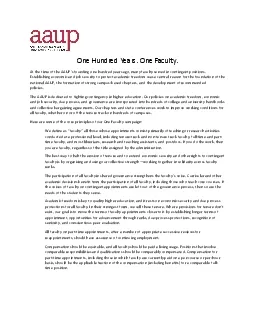

At the time of the AAUPs founding one hundred years ago many faculty served in contingent positionsEstablishing economic and job security to protect academic freedom was a central reason for the found ID: 867191
Download Pdf The PPT/PDF document "One Hundred Years One Faculty" is the property of its rightful owner. Permission is granted to download and print the materials on this web site for personal, non-commercial use only, and to display it on your personal computer provided you do not modify the materials and that you retain all copyright notices contained in the materials. By downloading content from our website, you accept the terms of this agreement.
1 One Hundred Years. One Faculty. At the
One Hundred Years. One Faculty. At the time of the AAUP’s founding one hundred years ago, many faculty served in contingent positions . Establishing economic and job security to protect academic freedom was a centr al reason for the foundation of the national AAUP, the formation of strong campus‐based chapters, and the development of recommended policies. The AAUP is dedicated to fig hting contingency in higher education. Our policie s on academic freedom, economic and job security, due process, and governance are incorporated into hun dreds of college and university handbooks and collective bargaining agreements. Our chapters and state conf erences work to improve working conditions for all faculty, whether on or off the tenure track on hundreds of campuses. Here are some of the core principles of our One Faculty campaign: We define as “faculty” all those whose appointments consist primar ily of teaching or research activities conducted at a professional level, including tenure‐track and non‐tenure tra ck faculty, full‐time and part‐ time faculty, and most librarians, research and teaching assistants, and pos tdocs. If you do the work, then y ou are faculty, regardless of the title assigned by the administration . The best way to halt the erosion of tenure and to extend economic security and other rights to contingent faculty is by organizing and using our collective strength — working together in solidarity across faculty ranks. The participation of all faculty in shared governance strengthens the facult y’s voice. Curricular and other academic decisions benefit from the participation of all faculty, including th ose who teach core courses. If the voices of faculty on contingent appointments are left out of the gove rnance process, then so are the needs of the students they serve. Acad emic freedom is key to quality higher education, and it rests on ec onomic security and due process protections for all faculty. In their strongest form, we call these tenure. Wh ere provisions for tenure don’t exist, our goal is to move the terms of faculty appointments closer to it by establishing longer terms of appointment, opportunities for advancement through ranks, due‐proc ess protections, recognition of seniority, and conscientious peer evaluation. All faculty on part‐time appointments, after a number of app ropriate successive reviews for reappointments, should have assurance of continuing employment. Compensation should be equitable, and all faculty should be paid a livi ng wage. Positions that involve comparable responsibilities and qualifications should be comparably comp ensated. Compensation for part‐ time appointments, including those in which faculty are currently paid on a per‐course or per‐hour basis, should be the applicable fraction of the compensation (including benefits) for a comparable f ull‐ time position.